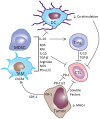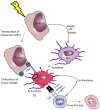Combinations of immunotherapy and radiation in cancer therapy
- PMID: 25506582
- PMCID: PMC4246656
- DOI: 10.3389/fonc.2014.00325
Combinations of immunotherapy and radiation in cancer therapy
Abstract
The immune system has the ability to recognize and specifically reject tumors, and tumors only become clinically apparent once they have evaded immune destruction by creating an immunosuppressive tumor microenvironment. Radiotherapy (RT) can cause immunogenic tumor cell death resulting in cross-priming of tumor-specific T-cells, acting as an in situ tumor vaccine; however, RT alone rarely induces effective anti-tumor immunity resulting in systemic tumor rejection. Immunotherapy can complement RT to help overcome tumor-induced immune suppression, as demonstrated in pre-clinical tumor models. Here, we provide the rationale for combinations of different immunotherapies and RT, and review the pre-clinical and emerging clinical evidence for these combinations in the treatment of cancer.
Keywords: abscopal effect; clinical trials; immunotherapy; ionizing radiation; microenvironment; radiotherapy; tumor immunity.
Figures


Similar articles
-
Integration of radiation and immunotherapy in breast cancer - Treatment implications.Breast. 2018 Apr;38:66-74. doi: 10.1016/j.breast.2017.12.005. Epub 2018 Jan 4. Breast. 2018. PMID: 29253718 Review.
-
Immune checkpoint inhibitors with radiotherapy and locoregional treatment: synergism and potential clinical implications.Curr Opin Oncol. 2015 Nov;27(6):445-51. doi: 10.1097/CCO.0000000000000225. Curr Opin Oncol. 2015. PMID: 26447875 Review.
-
The optimal partnership of radiation and immunotherapy: from preclinical studies to clinical translation.Radiat Res. 2014 Aug;182(2):170-81. doi: 10.1667/RR13500.1. Epub 2014 Jun 17. Radiat Res. 2014. PMID: 24937779 Free PMC article. Review.
-
Barriers to Radiation-Induced In Situ Tumor Vaccination.Front Immunol. 2017 Mar 13;8:229. doi: 10.3389/fimmu.2017.00229. eCollection 2017. Front Immunol. 2017. PMID: 28348554 Free PMC article. Review.
-
Immune Priming of the Tumor Microenvironment by Radiation.Trends Cancer. 2016 Nov;2(11):638-645. doi: 10.1016/j.trecan.2016.09.007. Epub 2016 Oct 15. Trends Cancer. 2016. PMID: 28741502 Review.
Cited by
-
Primary vaginal malignant melanoma successfully treated with combination therapy: A case report.Oncol Lett. 2022 Oct 19;24(6):430. doi: 10.3892/ol.2022.13550. eCollection 2022 Dec. Oncol Lett. 2022. PMID: 36311689 Free PMC article.
-
Trial Watch: Immunotherapy plus radiation therapy for oncological indications.Oncoimmunology. 2016 Jul 25;5(9):e1214790. doi: 10.1080/2162402X.2016.1214790. eCollection 2016. Oncoimmunology. 2016. PMID: 27757313 Free PMC article. Review.
-
Radiotherapy to Control Limited Melanoma Progression Following Ipilimumab.J Immunother. 2016 Nov/Dec;39(9):373-378. doi: 10.1097/CJI.0000000000000142. J Immunother. 2016. PMID: 27662339 Free PMC article.
-
Efficacy of Stereotactic Body Radiotherapy in Patients With Hepatocellular Carcinoma Not Suitable for Transarterial Chemoembolization (HERACLES: HEpatocellular Carcinoma Stereotactic RAdiotherapy CLinical Efficacy Study).Front Oncol. 2021 Mar 19;11:653141. doi: 10.3389/fonc.2021.653141. eCollection 2021. Front Oncol. 2021. PMID: 33816309 Free PMC article.
-
Fractionated Radiotherapy with 3 x 8 Gy Induces Systemic Anti-Tumour Responses and Abscopal Tumour Inhibition without Modulating the Humoral Anti-Tumour Response.PLoS One. 2016 Jul 18;11(7):e0159515. doi: 10.1371/journal.pone.0159515. eCollection 2016. PLoS One. 2016. PMID: 27427766 Free PMC article.
References
-
- Burnet M. Immunological factors in the process of carcinogenesis. Br Med Bull (1964) 20:154–8. - PubMed
Publication types
LinkOut - more resources
Full Text Sources
Other Literature Sources

